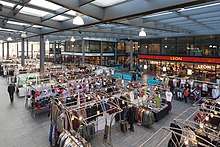Spitalfields Market
Spitalfields Market is a traders' market as well as a food and art market located in Spitalfields, Central London. Traders began operating around 1666, after the Great Fire of London, where the market stands today. The Spitalfields regeneration programme that ended in 2005, resulted in two new public spaces – Bishops Square and Crispin Place, restoration of several historic streets and more independent retailers and restaurants. Spitalfields Market is situated in the London Borough of Tower Hamlets. It is surrounded by Lamb Street, Old Spitalfields market, Brushfield Street and Bishops Square.

History
In 1682, King Charles II officially granted John Balch a Royal Charter allowing him to hold a market every Thursday and Saturday in Spital Square.
The reputation of the market encouraged Huguenot silk weavers to settle in the area. They were fleeing France, following the Revocation of the Edict of Nantes in 1685.[1] Some of their houses are still standing around Fournier Street, which is now a conservation area. Today many artists occupy those houses including Gilbert & George.
In the mid-1700s, Irish weavers also settled in the area following the decline in the Irish linen industry.
The growth in the area led to the establishment of Hawksmoor’s Christ Church in 1729, which consecrated Spitalfields becoming a parish in its own right.
After the Irish, a wave of Jewish refugees filled the area. Some had fled from Polish pogroms and Russia, while some were entrepreneurs from the Netherlands. Between the 1880s and 1970s, Spitalfields was one of the largest Jewish communities in England, having more than forty synagogues.
By mid-20th century, most of the Jewish community had left the area and since the 1970s, a Bangladeshi community has been flourishing. New cultures, trades and business now fill the area including the renowned Brick Lane restaurant district.
There is still some evidence of the various communities from the past that stand today – a Huguenot church, Methodist chapel, Jewish synagogue, and Muslim mosque amongst new stores, housing, restaurants and markets.
Spitalfields market was acquired by the City of London in 1920, and the original buildings were extended. By 1991 there was no longer any space left for expansion and the market was split (Old Spitalfields market stayed on the end of Brushfield Street that meets Commercial Street; while the fruit and vegetable market moved to Leyton and was named New Spitalfields Market). Then in 2005 as part of the redevelopment programme, the market split again. The new development known as Spitalfields, is located within the areas known as Bishops Square, Market Street & Crispin Place, which includes the Spitalfields Traders Market in Crispin Place. Directly adjacent with a seamless boundary and shared covered roof, is Old Spitalfields Market, situated in the Horner Buildings.
Spitalfields Market currently is opened every day of the week. It hosts various retail brands, street-food stalls, bars and restaurants, and independent traders showcasing handcrafted goods, artwork, fashion, and jewellery. It also hosts public art and events programmes.
See also
Notes
- "Spitalfields". British History Online. Institute of Historical Research. 2018-08-06.